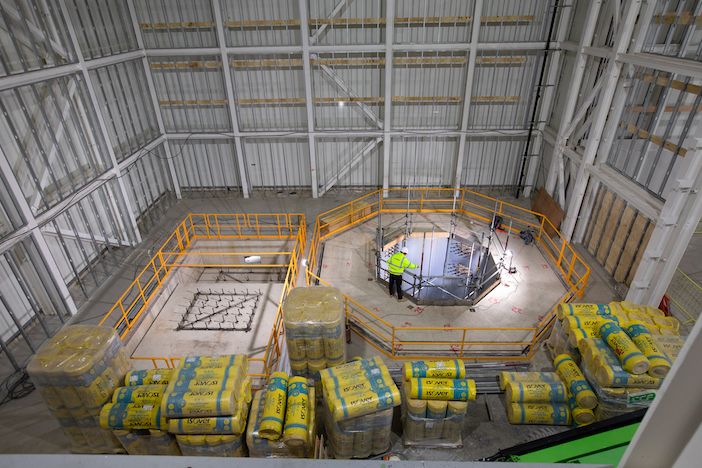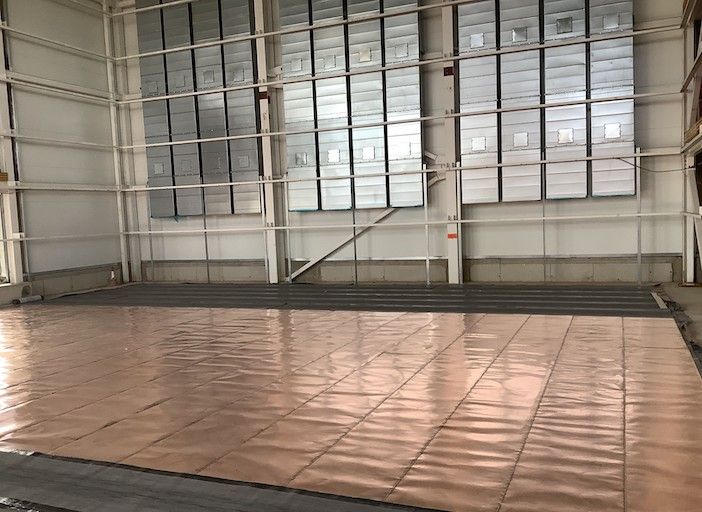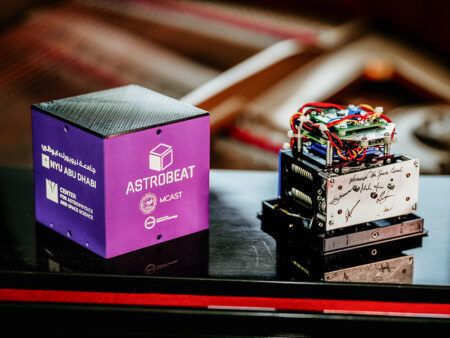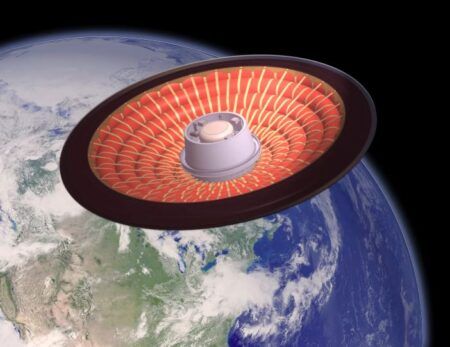The exterior of a the UK’s first co-located satellite test facility has been completed, signalling a major milestone in the build process which is due to complete next year.
The £105 million UK Government-funded National Satellite Test Facility (NSTF) is being built by construction firm Mace at the Rutherford Appleton Laboratory (RAL) Space site in Oxfordshire. The NSTF will provide the UK with the facilities for the assembly, integration and environmental testing of space payloads and satellites of up to 7000kg in a single building for the first time.
Earlier this month the last piece of more than 900 tonnes of steel framework was installed, after more than 3000mᶟ of concrete had been poured to complete the building’s main structure.
The NSTF is planned to become operational in 2022 and will be run by RAL Space, part of the UK’s Science and Technology Facilities Council. The testing facility features clean rooms for large satellite preparation and solar array deployment, equipment to test for centre of gravity and moments of inertia, vibration and pyro shock and acoustic testing equipment, thermal vacuum testing capabilities, an electromagnetic compatibility (EMC) chamber and a compact antenna test range.
The NSTF’s 98 tonnes environmental test chamber arrived from Angelantoni Test Technologies in Italy during June. The 7m x 12m long Large Space Test Chamber will be able to test minibus sized satellites for the harsh conditions of space in temperatures ranging from -180֯˚C to +100֯˚C.
Mace also recently installed the first piece of apparatus for the vibration facility, which will test satellites to ensure that they can withstand the bumpy ride into space.
Professor Chris Mutlow, director of RAL Space said, “I’m delighted that we’ve passed this milestone. We are well on our way to opening our doors to the space sector. Large satellites require at least six months of testing before they’re launched and this becomes longer and more expensive if all the test equipment is in different places.
“It’s fantastic to see the test equipment shaping up under one roof. The space sector in the UK is thriving and we’re looking forward to offering this one-stop-shop to support the development of larger and more advanced spacecraft in the UK.”
Vibration works
The suspension system, the first of the vibration equipment, has been successfully installed on the reaction masses, the two 250 tonne blocks on which the vibration system will stand. At the NSTF, two 222 kN thrust shakers will be used to simulate the vibration of launch and test the satellite in 3 axes, the equivalent of a fully loaded 25 seater bus being strapped to the top of a jack hammer.

More than 1500mᶟ of earth was removed from site so that the vibration equipment could be sunk into the ground. The suspension system causes the vibration facility to ‘float’ completely isolated from the rest of the building This ensures that the vibrations from the shaker will not affect any of the other measurements taking place in the NSTF or by other sensitive scientific equipment nearby on the Harwell Campus in Oxfordshire.
EMC chamber construction

Alongside the vibration facility, the NSTF will offer EMC and antennae testing. This requires an electrically neutral space, built into the fabric of the building. 290-square meters of copper sheet have been laid into the floor of the chamber. Over the next few months this will be joined with copper wall and ceiling panels to create a copper shield through which electromagnetic waves cannot pass.
Inside this ‘quiet’ zone satellite manufacturers will be able to accurately measure the ‘noise’ that satellite antennae produce, ensuring that we get a high quality signal back to Earth for our TVs, weather forecasts and science operations.
Rob Bridges project director for Mace said, “From the first design workshop my team have been challenged to bring together a blend of technologies and innovations to design and deliver a future proofed, flexible building that will not only house specialist testing equipment but is required to be integral to the testing providing a stable environment, whilst using the structure as a dynamic part of the testing process.”




